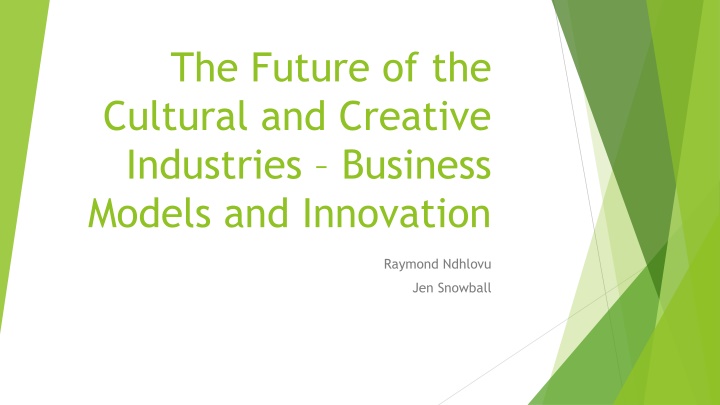
Survival and Evolution of Cultural and Creative Industries Amidst Challenges
Despite facing challenges such as event cancellations, shift to online platforms, and declining GDP contributions, the cultural and creative industries have shown resilience and adaptation in the face of adversity. Strategies like hybrid events and adherence to COVID protocols have enabled their continuity, reflecting the importance of innovation and flexibility in navigating uncertain times.
Download Presentation

Please find below an Image/Link to download the presentation.
The content on the website is provided AS IS for your information and personal use only. It may not be sold, licensed, or shared on other websites without obtaining consent from the author. If you encounter any issues during the download, it is possible that the publisher has removed the file from their server.
You are allowed to download the files provided on this website for personal or commercial use, subject to the condition that they are used lawfully. All files are the property of their respective owners.
The content on the website is provided AS IS for your information and personal use only. It may not be sold, licensed, or shared on other websites without obtaining consent from the author.
E N D
Presentation Transcript
The Future of the Cultural and Creative Industries Business Models and Innovation Raymond Ndhlovu Jen Snowball
UNESCO definition used: culture is the set of distinctive spiritual, material, intellectual and emotional features of society or a social group, that encompasses, not only art and literature, but lifestyles, ways of living together, value systems, traditions and beliefs. (UNESCO, 2009) Intangible nature of culture seen from definition (beliefs and values can t be directly measured) BUT possible to measure the associated behaviours that accompany the beliefs and values
UNESCO Framework for Cultural Statistics (FCS)
Context of Research
ONLY COOL PEOPLE ALLOWED CHECK YOUR TEMPERATURE Wear a mask or get the fork out of here Practice #safesix social distancing folks Be wise sanitise
How did CCIs survive 2020/2021? (barely) CCIs adopted one of three strategies; 1. Some CCIs (particularly festivals) completely cancelled the event for 2020/2021 2. Some went fully online 3. Towards the end of the period, some returned to live participation
Since then 1. Continuation of live events, COVID protocols allowing 2. Continued utilization of online platforms 3. HYBRID FESTIVALS AND CCI EVENTS
CCI Macro Contributions and Comparisons South Africa and Zimbabwe GDP Employment Internet Access South Africa 2.97% 6% 78.6% Zimbabwe 6.9% N/A 55.7% Source: SACO, 2020; 2021, Creatives Unlocked, 2020 In 2020, decline of approximately 50% from the 2019 GDP contributions in South Africa
Arts and Cultural also vulnerable to shocks such as the the 2008 financial crisis It is indeed the arts and culture that are at the very root of economic development and act as a catalyst for economic growth (Urbact, 2006) Therefore, the impact of the arts and cultural sector on the economy; overall economic growth and development, must be analysed
Business models The concept of business models encompasses: value creation, delivery of a value-processed goods to a market/market segments Mechanisms of value capture employed by the firm How all these elements are linked together
Components of business models What is the supply of cultural goods and services How are these goods and services produced By whom and by what means are relationships structured How much income is generated
Sustainable Business Models Sustainability in business models Triple Bottom Line
Business model dynamics Business model innovation Business model adaptation Business model evolution
Business Model Innovation Oslo Manual for measuring Innovation Product Innovation Process Innovation Marketing Innovation Organisational Innovation
Business Model Adaptation Rigidity Theory Path Dependency Theory
Investigate business models and adaptation strategies that CCIs in a well- resourced country adopt, compared to those in a less-resourced country, when faced with external shocks Investigate how SMMEs responded to COVID-19 in terms of business model innovation or consolidation Analyse the innovations and adaptation strategies adopted immediately vs those adopted in the longer term Compare the effects of COVID-19 on business operations, models and innovation processes of CCIs, in a well-resourced country, compared to those of a less resourced country, and the adaptation strategies that have been used in response to this shock Analyse and determine the success of these adaptation strategies
METHODS, PROCEDURES AND TECHNIQUES
Investigating the effects of COVID-19 on CCI businesses and models, and consequent adaptation strategies Stakeholder Interviews: CCIs that are mostly reliant on in-person production and consumption CCIs that are not mostly reliant on in-person production and consumption Thematic and categorical analysis, based on variables in BMI/BMA
